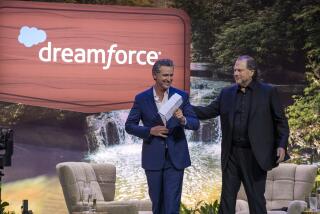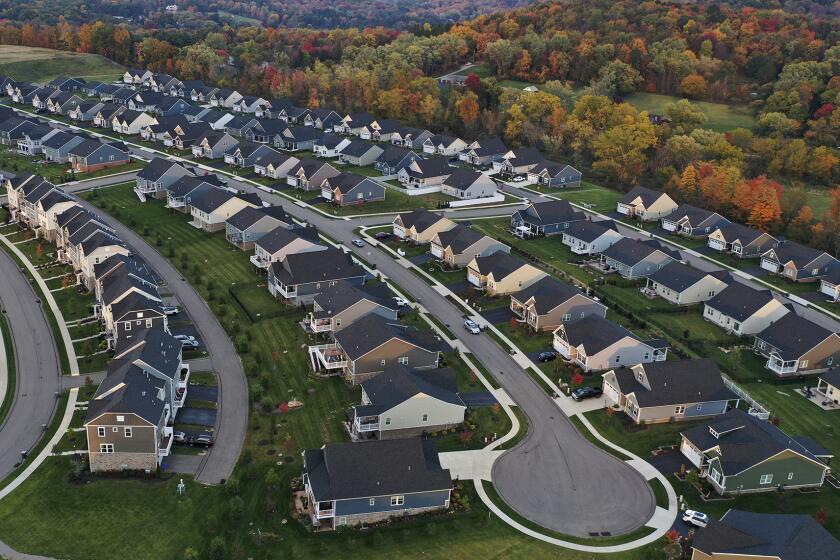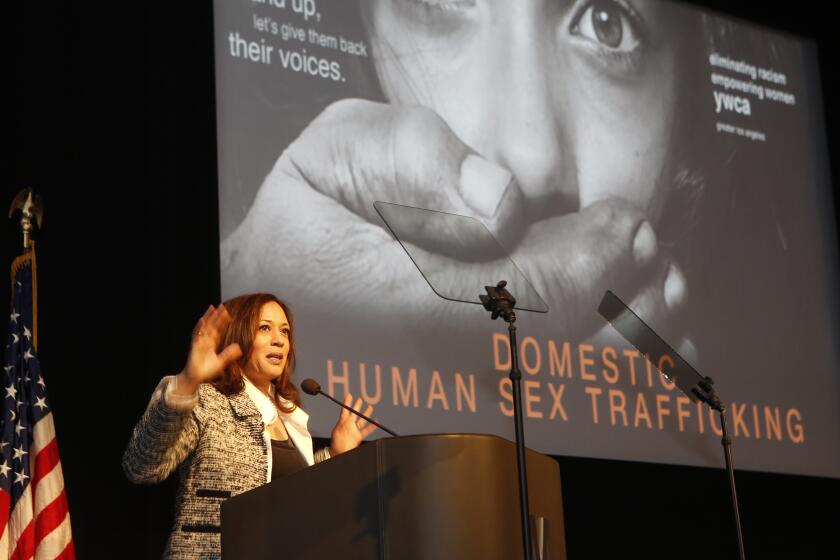Gov. Gavin Newsom pledges to scale back high-speed rail and twin-tunnels projects in State of the State speech

California Gov. Gavin Newsom said he intends to scale back the high-speed rail.
Reporting from Sacramento — Gov. Gavin Newsom announced in his first State of the State speech that he intends to scale back California’s $77-billion bullet train project, saying that while the state has the capacity to complete the first leg in the Central Valley, extending the rail line to Southern California and the Bay Area would “cost too much and, respectfully, take too long.”
The Democratic governor supports finishing the controversial high-speed rail line between Bakersfield and Merced, and said it would invigorate the economy in California’s midsection and reduce the region’s air pollution. But because of the project’s persistent cost overruns, mismanagement and delays, the grand vision of bullet trains whisking passengers from San Diego to San Francisco doesn’t appear viable and will need to be reassessed, Newsom said.
“There’s been too little oversight and not enough transparency,” Newsom said. “Right now, there simply isn’t a path to get from Sacramento to San Diego, let alone from San Francisco to L.A. I wish there were.”
Newsom also said he will continue to push for federal and private funding for the entire rail system, leading to some confusion about whether he planned to scrap all but the Central Valley portion or simply postpone construction of the remaining legs of the project. After the speech, a spokesperson for the governor’s office confirmed the latter.
In another break from his predecessor, Jerry Brown, the governor also announced in his speech Tuesday that he will downsize the Sacramento-San Joaquin River Delta twin-tunnels project to one tunnel.
Assembly Speaker Anthony Rendon (D-Lakewood) agreed with the governor and said the state needs to rethink its high-speed rail efforts. But he raised concerns about how scaling back the rail system fulfills the vision that voters approved.
“The extent to which it does not link two of the three largest urban areas in the state seems problematic,” Rendon said.
Sen. Jim Nielsen (R-Gerber) called Newsom’s plan “almost humorous.”
“We’re going to put more billions into a train in a place where there is no ridership and no freight will be hauled,” Nielsen said. “What economy is that going to improve in the Central Valley? I was raised there. I farmed there. It is not the answer for the valley.”
Newsom’s plans would take some of the project’s risks off the table but also create new ones.

The governor committed to completing the environmental reviews for the entire Anaheim to San Francisco route, citing the requirements of a grant agreement by the Federal Railroad Administration. If the state does finalize those reviews, it would open the window to environmental lawsuits.
The other major risk the state faces is running out of money, even with the truncated project.
In his late-morning address to lawmakers, Newsom also called for ambitious efforts to address the unbridled increase in homelessness in California and to care for the state’s rapidly aging population. Newsom promised to sign legislation to control the escalating cost of renting an apartment, and emphasized his administration’s efforts to spur cities and counties to meet the overwhelming need for affordable housing.
And as expected, he reiterated his steadfast opposition to the dictates of President Trump on immigration, climate change and other critical issues on which the state and federal government are at odds.
“He described a country where inequality doesn’t seem to be a problem, where climate change doesn’t exist and where the greatest threat we face comes from families seeking asylum,” Newsom said of the president’s State of the Union speech last week.
State of the State speeches typically provide governors a chance to lay out policy agendas and wish lists for the year ahead, and Newsom did not squander that opportunity. But he offered his audience, a joint session of the Assembly and Senate at the state Capitol, few specifics detailing how he hoped to deliver on many of his far-reaching initiatives.
“The tough calls we must make together on issues like rail, water and energy … how we protect migrants, care for seniors and help the homeless, and how above all else we will tackle the affordability crisis that is coming to define life in this state,” Newsom said, “I won’t pretend to have all the answers. But the only way to find them is to face these issues honestly.”
The twin-tunnels project, which would reconfigure the way Northern California water supplies are shipped south through the Sacramento-San Joaquin delta, has gone through several iterations over the years. The proposal originally called for construction of two massive water tunnels under the delta, the ecologically troubled center of the state’s water system.
After major agricultural districts backed away from commitments to help pay for the $17-billion water delivery project, state officials said they would press ahead with a less expensive, single-tunnel version. The Metropolitan Water District of Southern California revived the twin-tunnel proposal last spring when it voted to shoulder most of its cost.
Jeffrey Kightlinger, Metropolitan’s general manager, said he tried to persuade Newsom to stick with the two-tunnel plan. But given what the governor saw as “the lack of deep political support and a lack of people really willing to step up and finance it in the [agriculture] sector,” Kightlinger said Newsom wanted to “look at something smaller that is more feasible in the time frame we’re talking about.”
In his speech, Newsom said the status quo was “not an option” and that the water project is essential to protecting the fragile delta and water supply for farmers and millions of Californians.
“I do not support the twin tunnels. We can build, however, on the important work that’s already been done. That’s why I do support a single tunnel,” Newsom said.
One of the main precepts of Newsom’s short time in office has been to directly challenge the hard-line policies of the Republican president, taking particular aim at a Trump administration immigration policy that the governor sees as anathema to the interests of a state in which 27% of the population is foreign-born.
In his speech, Newsom said the president’s anti-immigrant rhetoric rippled through California decades ago with Propositions 187 and 227, requiring “English-only” public schools and banning immigrants in the U.S. illegally from government assistance and services, only to be struck down by the courts or later repealed.
“This is our answer to the White House: No more division, no more xenophobia and no more nativism,” Newsom said.
On Monday, Newsom ordered the removal of roughly 360 California National Guard members who had been stationed at the U.S-Mexico border for the last year, deployed by Brown at the request of the Trump administration.
“The border ‘emergency’ is nothing more than a manufactured crisis, and California will not be part of this political theater,” Newsom said, noting that border crossings are at their lowest level since 1971.
On his first day in office, Newsom also took a swipe at Trump by announcing plans for an expansion of Medi-Cal to cover young immigrants in the U.S. illegally and to require consumers in the state to carry health insurance, a mandate in the federal Affordable Care Act that was nixed in 2017 by the Trump administration and a Republican-led Congress.
“The White House is laser-focused, has been for years, on destroying the Affordable Care Act,” Newsom said. “The vandalism they’ve already done to the individual mandate has had consequences.”
As a result, premiums for Covered California, which administers the healthcare program, increased almost twice as much as expected, Newsom said. The governor’s proposed budget includes $1 billion to counter that financial hit and address the shortage of healthcare providers, he said.
Newsom, a former two-term lieutenant governor and San Francisco mayor, did manage to offer a few kind words about the Republican president. He praised Trump for bringing attention to the high cost of prescription drug prices in his State of the Union address. The governor already has called for California to create its own drug-purchasing system, a mammoth enterprise that he claimed would save residents hundreds of millions of dollars a year.
Newsom has shown himself to be “ambitious and measured,” dispelling concerns that he lacked the political maturity to resist overspending or immediately launch ill-conceived, massive new government programs, said San Jose State political scientist Melinda Jackson.
“I think he got off to a strong start, and I kind of feel like this is a golden moment for him. Everything is coming together,” Jackson said. “He seems to be moving toward an expanded safety net in California. I see this as California kind of becoming not just the resistance to Trump but an alternative.”
Newsom’s address Tuesday was a reminder of how much the state’s finances have recovered from the Great Recession, an era of seemingly insurmountable deficits with a tattered safety net for Californians flattened by the economic downturn.
The pragmatism of the last eight years under Brown, who steered California’s economic recovery, has been replaced with a progressive idealism of an ambitious governor who had the good political fortune of inheriting billions in surplus.
Newsom quickly showed he was not shy about spending that money. His $209-billion budget proposal, released in January, includes $1.8 billion to boost California’s enrollment in early education and child-care programs, $500 million to help local governments build shelters and add services to help the homeless, a $1-billion “working families tax credit,” and $1.3 billion for a new effort to build more homes and apartment units in a state starved for affordable housing.
During his first month in office, Newsom also launched a “strike team” to overhaul the problem-plagued Department of Motor Vehicles and called on state lawmakers to beef up a California Department of Justice unit responsible for enforcing laws on gun sales. He announced a goal to ensure that parents of newborns or newly adopted babies receive six months of paid leave, and he vowed to wrest control of the state’s Juvenile Justice Division away from corrections officials and have it run by government health and human services providers.
Newsom’s address Tuesday was interrupted several times by applause from Democrats, who hold super majorities in both the Assembly and Senate.
The governor’s wife, documentary filmmaker Jennifer Siebel Newsom, was in attendance. Noticeably absent was the couple’s 2-year-old son, Dutch, who stole the show during his father’s inaugural address when he climbed onstage and ambled around for a few minutes.
“We learned our lesson at the inauguration,” the governor said.
Times staff writers Bettina Boxall and Ralph Vartabedian contributed to this report.
Coverage of California politics »
Twitter: @philwillon
Updates on California politics
More to Read
Get the L.A. Times Politics newsletter
Deeply reported insights into legislation, politics and policy from Sacramento, Washington and beyond. In your inbox three times per week.
You may occasionally receive promotional content from the Los Angeles Times.












